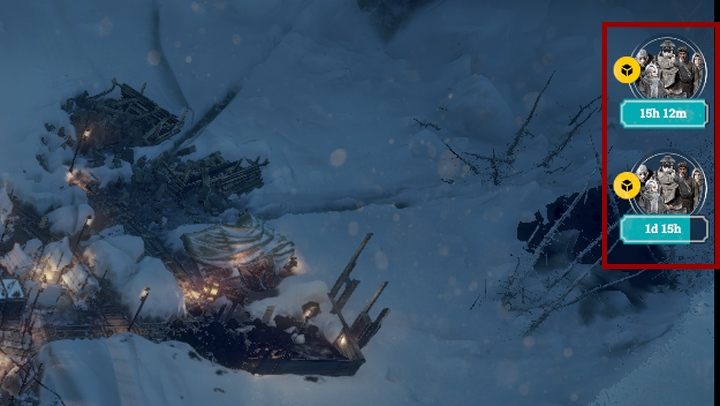
It takes your scouts precious in-game time to move there and back again, and every ‘node’ you visit is initially a total surprise. This ties into the scouting system, where you send parties of scouts to areas of interest in the ‘Frostland’. The storeline always keeps building during play, hitting you with new objectives and deadlines when you least need them sometimes soft deadlines, in that you’ll want to get them done as soon as possible, sometimes hard deadlines, of the ‘get this done before the clock runs out or else‘ variety. You’re not just building a city, you’re rebuilding the British way of life, or preserving vital plant seeds, or saving refugees. Frostpunk organizes its play in scenarios because it’s secretly a narrative-driven game at heart.

Where early-game Frostpunk is a game of scrounging for materials and ratcheting your town together before nightfall, later-game Frostpunk involves a lot of decision making on its economy overview screens - which, despite the tutorials not really introducing them, are a really helpful and intuitive way of visualizing resource flows.Īgain, I want to stress that this is a real thing that really happens.īut there’s more, of course there’s more. The stress induced by Frostpunk‘s early game is stellar, though it does drop off a little when you get to the mid-game and start unlocking the fancier technologies - the wall drills, steel mills, and coal mines that functionally provide infinite resources. You have to weigh your options carefully to make sure you get to where you need to be before the freebies run out and the temperatures start dropping.

But workers get sick from the cold and from hunger, and might contract frostbite and die, and hope falls and discontent rises as you keep pushing them to the limit.
#Frostpunk refugees generator
The resources you can initially extract (without the Generator running and without advanced research) are highly limited, and if you don’t get your studies done and your infrastructure in place before your wooden crates and ore piles run out, everything collapses. It becomes more imposing over time, too, until you get the sensation that Sauron himself is lurking in your town.Įspecially in the early-game, this ever-present risk of total failure drives everything. It takes only a few seconds to realize that keeping the Generator alive and active is always your #1 mission, under any circumstance.) The imposing brown-orange and omnipresent hum set against the white backdrop and howling winds of the outside immediately highlight that tower of heat as the beating heart of the city - or humming heart, if you will. (This is, as a final graphical note, superbly visualized by the Generator itself. And since all other buildings draw power from the Generator, in almost every circumstance a Generator failure means your city is going to freeze to death. But if you run out of coal in Frostpunk, the Generator stops working. Other city-builder games have ‘fail’ states, sure, but those never feel quite as oppressive: You might fail a scenario condition, or run out of the resources needed to take an action or perform an upgrade, or lag behind your competitors in score at the end. Gameplay-wise, Frostpunk is characterized more than anything else by the ever-present looming reality that you can fail. This almost looks like a place I wouldn’t mind living for a while. I said this stuff shouldn’t factor, but it factors a little bit, if we’re honest. The looks (and the sounds, for that matter) really bring the world of Frostpunk to life, getting you that much deeper in what it is you’re actually doing. Obviously the graphical quality is machine-dependent, and this stuff shouldn’t factor too much, but: I have actually just sat and watched in-game nights go by.

There are plenty of reasons why Frostpunk works, but before I address the mechanical stuff, let me reiterate one final time: This game is really pretty.

#Frostpunk refugees free
And since there’s no free play option, for good reasons, Frostpunk is definitely a game with a shelf life. I also don’t think you’ll generally play each Frostpunk scenario more than once or twice - depending on whether or not you beat it, and on how much you care about internal variety. It’s taken me about 10 hours to play through the first two scenarios, with a third one unlocked and at least a fourth one promised in the near future, if not more. I’ve been having a pretty great time with Frostpunk so far.


 0 kommentar(er)
0 kommentar(er)
